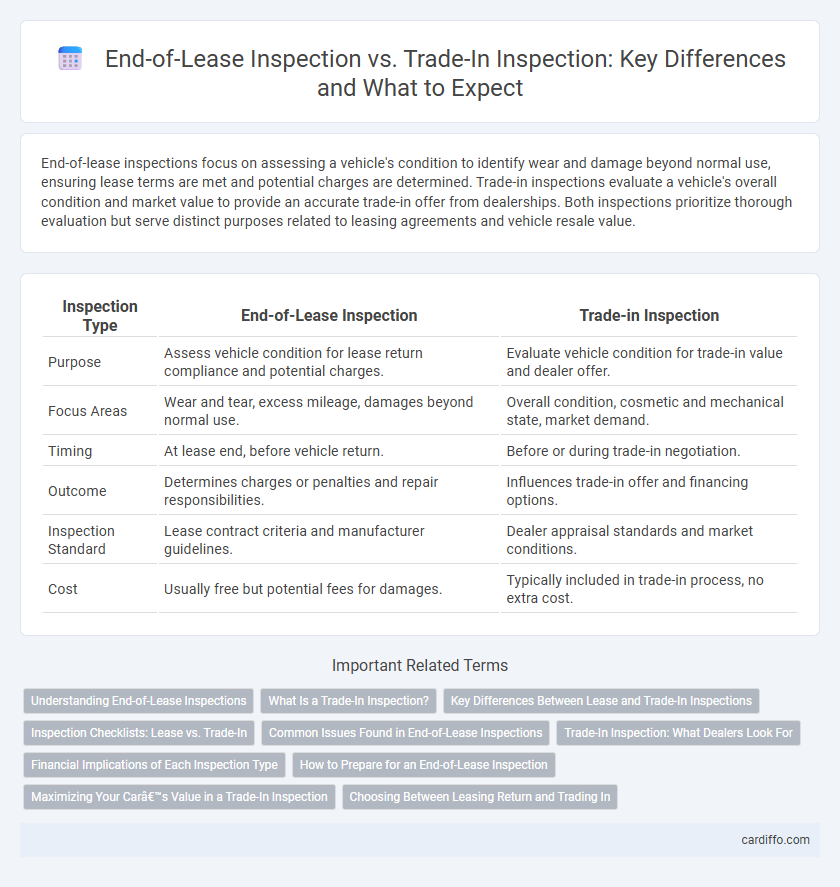End-of-lease inspections focus on assessing a vehicle's condition to identify wear and damage beyond normal use, ensuring lease terms are met and potential charges are determined. Trade-in inspections evaluate a vehicle's overall condition and market value to provide an accurate trade-in offer from dealerships. Both inspections prioritize thorough evaluation but serve distinct purposes related to leasing agreements and vehicle resale value.
Table of Comparison
| Inspection Type | End-of-Lease Inspection | Trade-in Inspection |
|---|---|---|
| Purpose | Assess vehicle condition for lease return compliance and potential charges. | Evaluate vehicle condition for trade-in value and dealer offer. |
| Focus Areas | Wear and tear, excess mileage, damages beyond normal use. | Overall condition, cosmetic and mechanical state, market demand. |
| Timing | At lease end, before vehicle return. | Before or during trade-in negotiation. |
| Outcome | Determines charges or penalties and repair responsibilities. | Influences trade-in offer and financing options. |
| Inspection Standard | Lease contract criteria and manufacturer guidelines. | Dealer appraisal standards and market conditions. |
| Cost | Usually free but potential fees for damages. | Typically included in trade-in process, no extra cost. |
Understanding End-of-Lease Inspections
End-of-lease inspections involve a detailed evaluation of a leased vehicle's condition to identify wear and tear beyond normal use, which may result in charges at lease end. These inspections assess factors such as tire tread depth, paint damage, interior cleanliness, and mechanical functionality according to lease agreement standards. Understanding the differences from trade-in inspections is crucial, as end-of-lease assessments prioritize contractual return conditions rather than resale value optimization.
What Is a Trade-In Inspection?
A trade-in inspection is a detailed assessment conducted by dealerships to evaluate the condition and value of a vehicle being traded in for another. This inspection covers key aspects such as engine performance, exterior and interior condition, tire wear, and any necessary repairs or maintenance. The results directly impact the trade-in offer, helping both the dealer and customer determine a fair market value.
Key Differences Between Lease and Trade-In Inspections
End-of-lease inspections primarily assess vehicle condition against lease agreement standards, focusing on wear and tear to determine potential charges. Trade-in inspections evaluate overall market value, considering cosmetic condition, mechanical performance, and mileage to negotiate trade-in offers. Lease inspections emphasize contract compliance, while trade-in inspections prioritize resale value optimization.
Inspection Checklists: Lease vs. Trade-In
End-of-lease inspection checklists emphasize wear and tear assessment, tire condition, and damage beyond normal use, ensuring lease return compliance. Trade-in inspection checklists prioritize overall vehicle condition, market value factors, and maintenance records to accurately appraise trade-in value. Both inspections require thorough evaluation but differ in criteria focus to meet lease agreement standards versus resale optimization.
Common Issues Found in End-of-Lease Inspections
End-of-lease inspections commonly reveal issues such as excessive tire wear, dents, scratches, and interior stains or damage that exceed normal wear and tear. These inspections also frequently identify mechanical problems like brake wear or fluid leaks that may not be addressed in trade-in evaluations. Unlike trade-in inspections, end-of-lease assessments emphasize condition compliance per lease agreement standards to avoid additional fees.
Trade-In Inspection: What Dealers Look For
Trade-in inspections primarily focus on assessing the vehicle's overall condition, including mechanical functionality, bodywork integrity, and tire wear, to determine its resale value. Dealers meticulously examine maintenance records, evaluate any existing damages, and check for potential safety issues such as brake performance and fluid leaks. The inspection outcome heavily influences trade-in offers by quantifying repair costs and market demand for the specific vehicle model.
Financial Implications of Each Inspection Type
End-of-lease inspections assess vehicle condition to determine potential charges for excess wear and tear, directly influencing lessees' final financial obligations. Trade-in inspections evaluate the car's market value and condition to establish trade-in credit, impacting the negotiation power and overall financial outcome in purchasing a new vehicle. Understanding these differences allows consumers to better manage costs related to lease returns versus trade-in transactions.
How to Prepare for an End-of-Lease Inspection
Prepare for an end-of-lease inspection by thoroughly cleaning your vehicle inside and out, repairing any minor damages such as scratches or dents, and ensuring all scheduled maintenance is up to date. Documenting the vehicle's condition with dated photos can provide proof of care and help resolve potential disputes. Reviewing the lease agreement for specific inspection criteria and scheduling the inspection before the lease ends optimizes readiness and minimizes unexpected charges.
Maximizing Your Car’s Value in a Trade-In Inspection
Trade-in inspections focus on identifying cosmetic and mechanical repairs that can increase your vehicle's resale value, unlike end-of-lease inspections that primarily assess condition against lease terms. Optimizing the car's appearance through touch-ups, detailing, and fixing minor damages can significantly boost trade-in offers. Ensuring all maintenance records are up to date also enhances buyer confidence and maximizes the vehicle's market value.
Choosing Between Leasing Return and Trading In
End-of-lease inspection evaluates a leased vehicle's condition against lease agreement standards to identify potential wear-and-tear charges, while trade-in inspection appraises the vehicle's market value for resale purposes. Choosing between leasing return and trading in depends on factors such as remaining lease obligations, vehicle equity, and immediate cash flow needs. Assessing mileage limits, repair costs, and trade-in offers helps determine the most economically advantageous option.
End-of-Lease Inspection vs Trade-in Inspection Infographic

 cardiffo.com
cardiffo.com